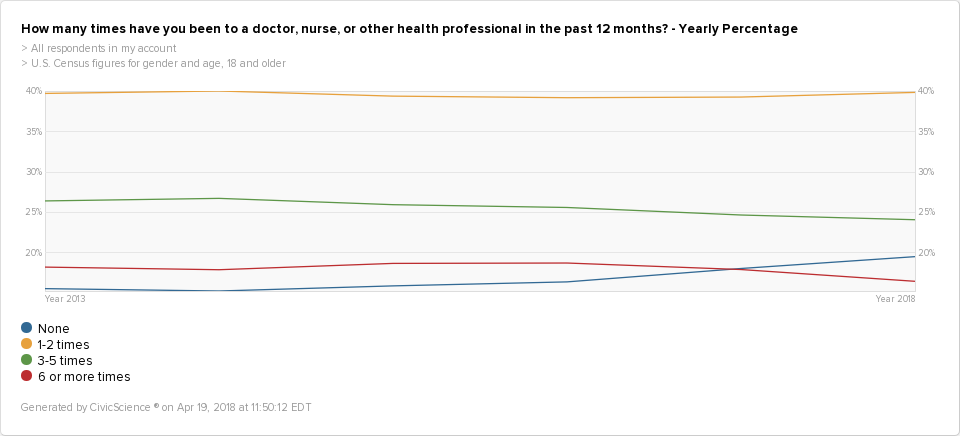The Gist: Whether you view access to basic healthcare as a privilege or a right, we found an interesting trend in our data – namely a declining number of average yearly doctor visits among the U.S. adult population beginning in 2015.
We’ll start with a graph for you. Focus your eyes on the red and blue lines. Beginning in 2015, people who haven’t seen a health professional in the past year has only grown, with a simultaneous decline of adults going six or more times annually.
There’s no shortage of ideas as to why. The ACA kicked off in full-force the prior year (2014). Be it misinformation or general confusion about how it worked, high premiums and deductibles, or access to physicians who accepted this form of insurance, the decline could be to be a reaction to changes in health care availability in the country. And it may even be the fact that paying for the insurance alone was too cost-prohibitive, so much so that visiting the doctor was out of the question. These are just theories, but it’s known that the cost of health care has people scared to go to the doctor.
When comparing U.S. adult visits in the past year to health insurance type (and excluding those without it), the post-ACA effect on doctor visits does hold water:
The chart shows that those who have insurance through the ACA are more likely than other insurance holders to have not seen a health professional in the past year. But, it also shows that across the board, insurance type doesn’t fully discriminate. People aren’t going to the doctor too often, even if their employer pays for the plan. The costs associated with seeking care may be too dang high.
So, who’s going to the doctor less frequently over the past year?
No surprise that this group of never-goers (who make up 20% of U.S. adults) is more likely to make under $50,000 annually. They are also much more likely to be unemployed compared to the general population. But, maybe a bigger surprise is that this group ranges in age.
Both Millennials and Gen Xers are more likely than other age groups to say they haven’t visited a health professional in the past year (the Millennial group being the most likely to say none). We know Gen Xers are crippled by debt, and perhaps the thought of medical bills deters them from making an appointment. The never-goers are also much less likely to take vitamins or supplements. Smokers are more likely to have not been to the doctor even once this year.
Generally healthy people are more likely to answer None–therefore we can speculate that people aren’t seeking preventative care, even if they consider themselves to be fine, likely because they cannot afford to.
We also found a regional correlation: People who live in the US West are more likely to answer None. We’ve seen that in some parts of the US West, health care is the most expensive in the nation. Men are more likely to be never-goers.
Did this group look any different in 2014 before the decline started?
Not really. In fact, the makeup of U.S. adults by generation of never-goers is nearly identical in 2014 to this group over the last 365 days. Same with income.
This comes down to one’s opinion of their own health, how much money they make and therefore, have in their pockets to spend. Renters are more likely than homeowners to not go to the doctor. As are city dwellers. So no surprises. Even though the Affordable Care Act aimed to make health care affordable, it may not have done it. The general increase in health care costs is a trend, too.
It appears that though the makeup of who didn’t go to the doctor pre-ACA and post-ACA (over the past year) is nearly the same, except the percentage of U.S. adult never-goers is even higher– now at 20%.
People’s decision to go to the doctor comes down to how much money they have on-hand. In the era of President Trump, how will lower income individuals’ access to basic doctor visits change? We hope for the better, but we’ll track it to see.










